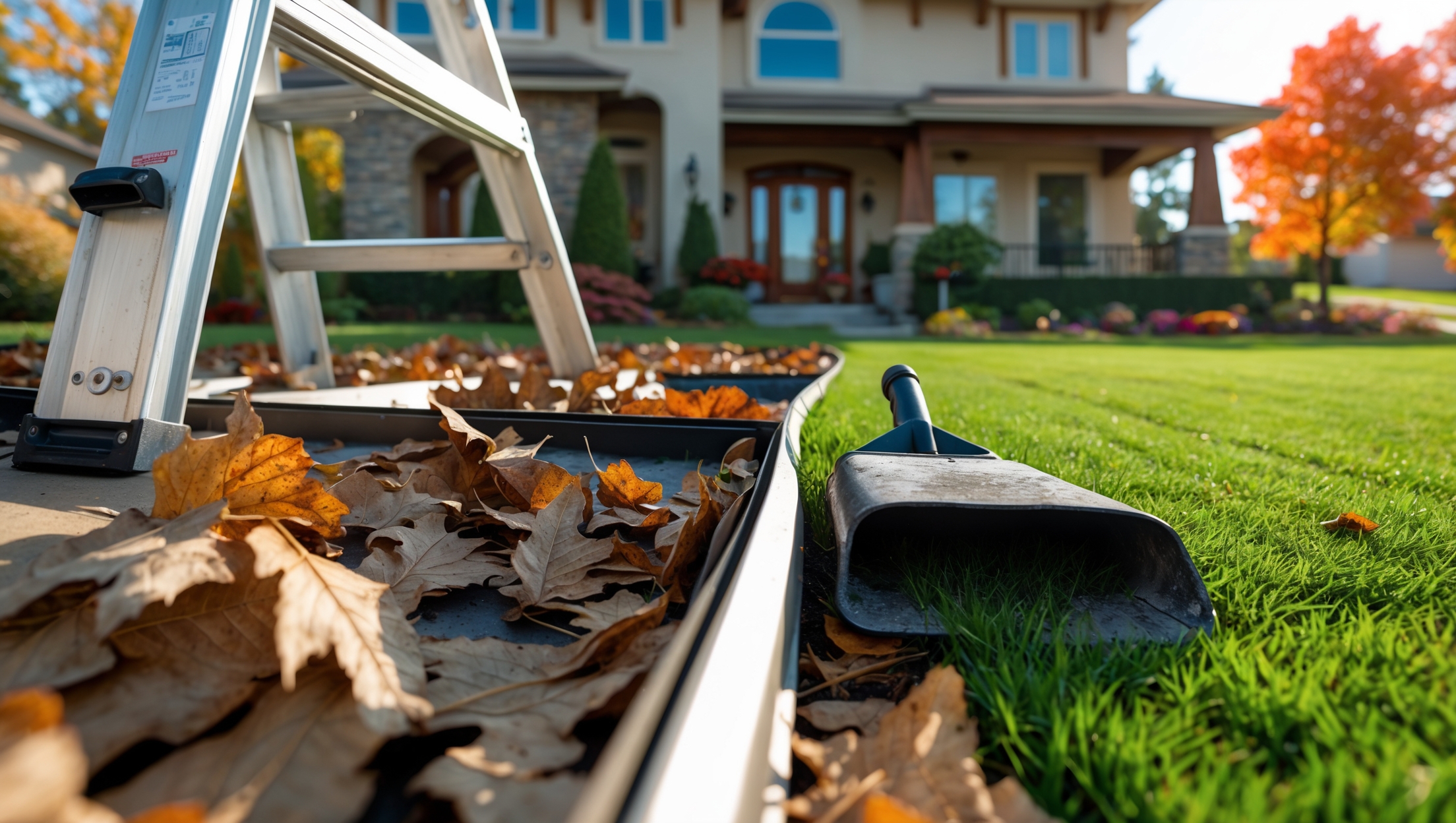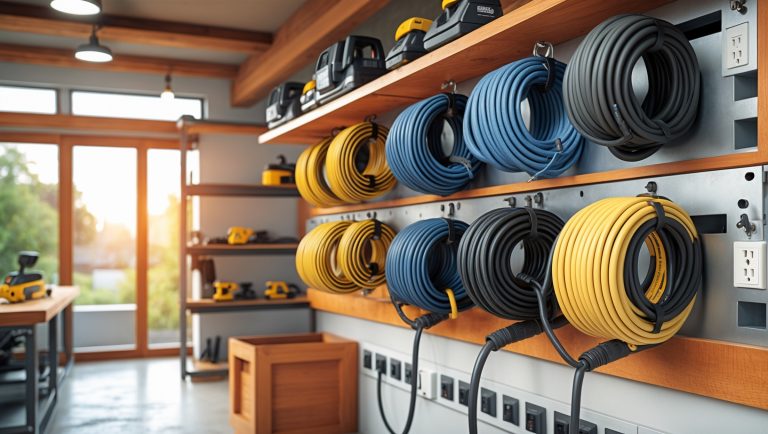Introduction: Why DIY Gutter Maintenance Matters
Gutters are the unsung heroes of home maintenance, quietly directing rainwater away from your roof and foundation. When neglected, clogged gutters can lead to a cascade of costly problems: water damage, mold growth, landscape erosion, and even compromised structural integrity. While professional cleaning services are an option, many homeowners can save significant money and gain peace of mind by tackling gutter maintenance themselves—provided they use the right tools, equipment, and safety practices. This comprehensive guide dives deep into the practicalities of DIY gutter cleaning. You’ll discover which tools make the job faster and safer, how to prepare and execute a thorough cleaning, and essential safety precautions to prevent injuries. Whether you’re a first-timer or looking to upgrade your gear, you’ll find actionable advice to keep your gutters flowing and your home protected, season after season.
Understanding Gutter Cleaning: What’s Involved?
The Role of Gutters in Home Protection
Gutters channel rainwater away from your home’s roof, walls, and foundation, preventing a host of issues including basement flooding, siding rot, and soil erosion. Clogged gutters trap water, which can overflow and seep where it shouldn’t, causing both immediate and long-term damage. Routine maintenance is crucial—especially after heavy leaf fall or storms.
Signs Your Gutters Need Attention
- Water spilling over gutter edges during rain
- Visible debris buildup (leaves, twigs, moss)
- Sagging or detached gutter sections
- Peeling paint or mildew on siding below gutters
- Plants growing in the gutters
Address these signs promptly to avoid expensive repairs down the line.
Essential Tools and Equipment for DIY Gutter Cleaning
Core Cleaning Tools
- Sturdy Ladder: Always use a ladder tall enough to reach your gutters without overreaching. An extension ladder is best for multi-story homes; a step ladder suffices for single-story homes.
- Gutter Scoop or Trowel: Specially shaped, plastic or metal scoops make it easy to remove compacted debris without damaging the gutter.
- Work Gloves: Heavy-duty, waterproof gloves protect your hands from sharp debris, insect nests, and dirty water.
- Bucket or Debris Bag: Attach a bucket to your ladder or use a debris bag to collect leaves and gunk as you work, minimizing cleanup time.
- Garden Hose with Spray Nozzle: A hose flushes out remaining dirt and checks for proper water flow and leaks.
- Gutter Cleaning Wand: Telescoping wands with curved ends allow you to blast away debris from the ground—handy for DIYers who wish to avoid ladders.
Optional Equipment for Efficiency
- Leaf Blower Attachment: Special gutter attachments for leaf blowers can quickly clear dry leaves from gutters without manual scooping.
- Wet/Dry Vacuum Attachments: Use these to suck up compacted debris, especially in hard-to-reach spots.
- Gutter Guards: While not a cleaning tool, installing guards can drastically reduce future cleaning frequency.
Personal Protective Equipment (PPE)
- Safety Glasses: Protect your eyes from flying debris and dirty water.
- Non-Slip Shoes: Wear shoes with excellent grip to prevent ladder slips.
- Long-Sleeve Shirt and Pants: Shields skin from scratches, insects, and irritants.
- Dust Mask (Optional): Useful if you have allergies or are cleaning especially dusty gutters.
Step-by-Step Gutter Cleaning Tutorial
1. Prepare the Area
- Check the weather—choose a dry, mild day for safe ladder use and easier debris removal.
- Clear the area below your gutters of obstacles (furniture, garden tools, decorations).
- Inform someone in your household that you’ll be working on a ladder for safety reasons.
2. Set Up Your Ladder Safely
- Place the ladder on firm, level ground. Use ladder stabilizers or standoff arms to prevent damage to gutters and add stability.
- Never lean out or overreach—move the ladder as needed.
3. Remove Large Debris
- Wearing gloves, use your gutter scoop or trowel to remove leaves, twigs, and sediment, starting near a downspout and working away from it.
- Deposit debris into your bucket or bag, not onto the ground for easier cleanup.
4. Flush the Gutters
- Once large debris is removed, use a garden hose with a spray nozzle to flush out remaining grime.
- Check for proper water flow—if water pools or drains slowly, there may be a clog in the downspout.
5. Clear Downspouts
- If water isn’t flowing freely, spray water up the downspout from the bottom or use a plumber’s snake to dislodge clogs.
- Repeat until water runs clear and unimpeded.
6. Inspect for Problems
- Look for leaks, sagging sections, rust, or loose fasteners.
- Seal minor leaks with silicone caulk; tighten or replace fasteners as needed.
- Note any areas needing professional repair.
7. Clean Up
- Dispose of debris responsibly—compost leaves and organic matter if possible.
- Rinse tools, wipe down gloves, and store everything for next time.
Safety Checklist: Preventing Accidents and Injuries
- Always use the right ladder for your home’s height and avoid makeshift supports.
- Maintain three points of contact with the ladder at all times (two hands and one foot or two feet and one hand).
- Never work alone—have someone nearby in case of emergencies.
- Inspect your ladder for defects before use.
- Keep tools in a bucket attached to the ladder with a lanyard, not in your pockets.
- Don’t use the top rung of the ladder.
- Stop immediately if you feel dizzy or unwell.
- Be cautious of power lines and overhead hazards near gutters.
Maintenance Frequency: When and How Often Should You Clean?
The ideal cleaning frequency depends on your environment:
- Heavily wooded areas: Clean gutters 3–4 times a year—early spring, late summer, autumn after leaf fall, and after major storms.
- Light foliage: Twice a year—once in late spring and again in autumn.
- With gutter guards installed: Inspect and lightly clean once a year, as guards can still allow small debris through.
Set calendar reminders to stay consistent and avoid forgotten maintenance.
Comparing Gutter Cleaning Tools: Manual vs. Powered vs. Ground-Based Solutions
Manual Cleaning (Ladder-Based)
- Pros: Most thorough, allows for close inspection and spot repairs.
- Cons: Time-consuming, requires working at height, more physically demanding.
Powered Tools (Blower/Vacuum Attachments)
- Pros: Fast for dry debris, less manual labor.
- Cons: Can miss wet or compacted gunk, attachments may not fit all gutters, still may require ladder use for optimal results.
Ground-Based Tools (Telescopic Wands)
- Pros: No ladder needed, safer for single-story homes, good for light debris.
- Cons: Less precise, may struggle with stubborn clogs or heavy buildup, can be messy.
For most homeowners, a combination of manual and powered tools yields the best results—especially for initial deep cleans and regular maintenance.
Gutter Guards: Are They Worth It?
Gutter guards (screens, mesh covers, foam inserts) promise to reduce cleaning frequency by blocking leaves and debris. While they can be effective, they’re not foolproof. Small debris, seeds, and roof grit can still enter and accumulate over time. Gutter guards require periodic inspection and cleaning themselves. Consider them a supplement—not a replacement—for regular maintenance. When choosing guards, ensure compatibility with your gutter type and local foliage.
DIY Gutter Maintenance Cost Breakdown
Here’s what you can expect to invest in basic DIY gutter cleaning:
- Ladder: $80–$200 (one-time)
- Gutter Scoop/Trowel: $5–$15
- Work Gloves: $10–$20
- Bucket/Debris Bag: $5–$20
- Garden Hose: $20–$60 (if you don’t already own one)
- Safety Glasses: $5–$15
- Leaf Blower Attachment (optional): $20–$40
- Gutter Cleaning Wand (optional): $25–$60
Compared to professional cleaning ($100–$300 per visit), the DIY route quickly pays for itself—especially if you already own a ladder and hose.
Common DIY Gutter Cleaning Mistakes to Avoid
- Skipping safety gear—never underestimate the risk of falls and injuries.
- Overreaching from the ladder instead of repositioning it.
- Forgetting to flush gutters and downspouts after removing debris.
- Ignoring minor leaks, which can worsen over time.
- Neglecting gutter guards (if installed), allowing debris accumulation underneath.
- Cleaning during wet, windy, or icy weather—always wait for safe conditions.
Pro Tips for Hassle-Free Gutter Maintenance
- Use a ladder stabilizer for added security and to prevent gutter damage.
- Wear a tool belt or use a bucket with a lanyard to keep hands free.
- Start at the downspout and work away—this prevents pushing debris into the drain.
- After cleaning, run a hose through each section to confirm proper drainage and check for leaks.
- Install downspout extenders to direct water further from your foundation.
- Keep a small supply of fasteners, sealant, and gutter hangers on hand for quick repairs.
- If you’re uncomfortable on ladders or your roof is especially high, don’t hesitate to call a professional for help.
Conclusion: Keep Your Gutters Clean—And Your Home Secure
DIY gutter maintenance is one of the most cost-effective and impactful home care tasks you can undertake. With the right tools, equipment, and attention to safety, homeowners can protect their investment, prevent expensive damage, and extend the life of their gutter system. Taking the time to clean your gutters seasonally ensures rainwater is safely channeled away, preserving your roof, siding, landscaping, and foundation. Remember, the key to hassle-free cleaning is preparation: invest in quality gear, follow a systematic approach, and never cut corners on safety. If you’ve been putting off gutter cleaning due to uncertainty or dread, use this guide as your confidence booster and checklist. The result is not just a cleaner gutter, but a safer, more resilient home for years to come. Stay proactive, stay safe, and enjoy the peace of mind that comes with well-maintained gutters.











Could you clarify what specific safety precautions I should take when using an extension ladder for two-story gutter cleaning? I am especially concerned about preventing falls or damaging the gutters while working alone.
When cleaning gutters on a two-story home with an extension ladder, always set the ladder on firm, level ground and angle it properly—about one foot away from the wall for every four feet of height. Secure the ladder by having someone hold it or using stabilizers, especially if working alone. Avoid leaning the ladder directly on gutters, as this can cause damage; ladder standoffs help protect them. Wear slip-resistant shoes and never overreach—keep your belt buckle between the ladder rails. Move the ladder frequently instead of stretching to reach a spot.
If my gutters are already starting to sag in a few spots, is it safe to clean them myself with just a sturdy ladder, or should I fix the sagging sections first? I want to avoid causing any more damage.
If your gutters are sagging, it’s best to address those sections before cleaning. Cleaning sagging gutters can put extra stress on already weakened areas, risking further damage or even a collapse. Secure the sagging spots by tightening or replacing the hangers first, then proceed with cleaning once everything feels stable and properly supported.
You mentioned using an extension ladder for multi-story homes, but I’m always worried about ladder safety. Are there any specific ladder accessories or features you recommend to make the job safer, especially for someone working alone?
Absolutely, ladder safety is crucial, especially when working alone. Consider using ladder stabilizers or standoff arms, which help keep the ladder steady and away from the gutter. Non-slip rubber feet are also important for preventing slipping. A ladder leveler is useful if you’re working on uneven ground. Additionally, a tool belt or a bucket with a hook can keep your hands free and reduce the risk of dropping tools while you work.
If I want to invest in just the basic tools first since I’m on a tight budget, which items would you say are absolutely essential for safe and effective gutter cleaning, and which can wait until later?
For safe and effective gutter cleaning on a budget, start with a sturdy ladder, work gloves, and a gutter scoop or small plastic trowel. A bucket to collect debris and safety glasses are also helpful but not essential right away. You can hold off on specialized tools like gutter cleaning attachments for hoses or leaf blowers until later.
I noticed mildew on the siding below my gutters, as mentioned in your list of signs. If gutter cleaning doesn’t solve this right away, what steps would you suggest to both clean the mildew and prevent it from returning in the future?
If gutter cleaning doesn’t immediately solve the mildew issue, start by scrubbing the affected siding with a mix of water and mild detergent, or use a solution of one part bleach to three parts water for tougher stains. Rinse thoroughly. To prevent mildew from coming back, ensure your gutters drain properly, keep downspouts clear, and trim back plants for better airflow and sun exposure. Regularly inspect both gutters and siding, addressing any leaks or moisture buildup quickly.
I’m new to gutter maintenance and the article mentions using a sturdy ladder for safety. Are there any specific ladder safety tips or recommended ladder types for someone who’s not very experienced with heights?
For those new to gutter maintenance and less comfortable with heights, it’s best to use a sturdy, well-balanced ladder like an extension or multi-position ladder. Always place the ladder on a flat, stable surface and make sure it locks securely. Avoid leaning too far to one side—move the ladder instead. Having someone nearby to hold the base can add extra safety. Never stand on the top two rungs and keep three points of contact (both feet and one hand) with the ladder at all times.
For someone on a tight budget, do I really need to invest in all the specialized gutter tools mentioned, or are there some basic household items that can get the job done safely and effectively?
You don’t need to buy every specialized gutter tool if you’re on a tight budget. Many people use a sturdy ladder, work gloves, a small plastic scoop or trowel, and a garden hose to clean gutters effectively. Just make sure your ladder is stable and always prioritize safety. Basic household items can do a good job as long as you take your time and work carefully.
The article lists signs like plants growing in gutters and peeling paint as indicators for cleaning, but how often do you recommend checking for these problems throughout the year, especially in areas with lots of trees?
In areas with lots of trees, it’s best to check your gutters for issues like plant growth and peeling paint at least every three months. During peak leaf fall in autumn and after major storms, you might want to inspect even more frequently to prevent clogs and damage. Regular checks ensure your gutters stay clear and in good condition.
After cleaning the gutters, is there a certain maintenance schedule you suggest for keeping them clear, especially in areas with lots of trees? Should I clean them after every storm or just in the fall and spring?
In areas with lots of trees, it’s best to check your gutters at least every three months—typically in early spring, late summer, and after the leaves fall in autumn. You don’t need to clean them after every storm, but inspect them if there’s been heavy wind or rain, as debris can quickly accumulate. Regular checks help prevent clogs and water damage.
I’ve read that safety is a big concern during DIY gutter cleaning. Are there specific ladder features or accessories you recommend for people like me who have never worked on a multi-story home before?
For multi-story homes, choose a sturdy extension ladder rated for your weight and height needs. Look for ladders with slip-resistant feet and wide, comfortable steps. Ladder stabilizers or stand-off arms help keep the ladder steady and prevent it from resting directly on gutters. Always consider using a harness system if you’re working at significant heights. Having someone nearby to help hold the ladder adds an extra layer of safety.
When it comes to safety precautions for DIY gutter cleaning, do you have any recommendations for homeowners who have particularly steep or high roofs? I’m concerned about working on two-story homes and want to make sure I’m taking the right steps.
For steep or high roofs, safety is crucial. Use a sturdy, extendable ladder with stabilizers and always place it on a flat, solid surface. Consider wearing a safety harness secured to an anchor point on the roof. Avoid leaning too far while on the ladder, and never work alone—have someone nearby in case of emergencies. For two-story homes, it may be safer to use gutter cleaning tools with long poles from the ground or hire a professional if you feel uneasy.
For someone on a college student budget, what are the most essential gutter cleaning tools that can’t be replaced with common household items? Is it possible to do a decent job without buying a lot of specialized equipment?
You can actually do a pretty good job cleaning gutters with just a sturdy ladder, gloves, and a small plastic scoop or trowel—many people use an old kitchen spatula. Most specialized tools are nice but not essential. Just make sure your ladder is stable and always work with a friend if you can. A hose with a spray nozzle also helps to flush out debris, but it doesn’t have to be anything fancy.
You mention the importance of using a sturdy ladder, especially for multi-story homes. Are there certain ladder safety features or accessories you would recommend for someone concerned about stability while cleaning gutters alone?
For added stability when cleaning gutters alone, look for ladders with slip-resistant feet and wide, stable bases. Accessories like ladder stabilizers or standoff arms can keep the ladder securely positioned against the house without damaging gutters. A tool tray attachment can help keep your hands free, reducing the chance of losing balance as you work.
If gutters are showing signs like water spilling over during rain or plants growing inside, is it usually enough to just clean them out, or would you suggest checking for deeper drainage issues as well?
If you’re noticing water spilling over or plants growing in your gutters, cleaning them is definitely the first step. However, those symptoms can also point to deeper issues like blockages in downspouts or improper drainage away from your foundation. After cleaning, check that water flows freely through the downspouts and away from your house. If problems persist, it’s wise to investigate for clogs or drainage issues.
The article mentions using an extension ladder for multi-story homes and a step ladder for single-story homes. Are there any specific ladder safety features or brands you recommend for someone who’s planning to clean larger gutters for the first time?
When cleaning larger gutters, look for ladders with non-slip feet, sturdy locking mechanisms, and a load rating that exceeds your body weight plus tools. Choose an extension ladder made of fiberglass for better stability and non-conductivity. Brands like Werner and Louisville are well-known for their reliability and safety features. Always ensure your ladder extends at least three feet above the roofline and never lean too far while working.
I noticed you list visible debris and water overflow as signs gutters need attention. Is there a typical timeframe after heavy storms or leaf falls when I should schedule cleanings, or does it really just depend on what I see up there?
While visible debris and overflow are good indicators, it’s wise to schedule cleanings proactively, especially after heavy storms or peak leaf fall. For most homes, checking and possibly cleaning gutters every three to four months works well. However, if you have lots of nearby trees or recent storms, inspecting them within a week or two can prevent issues before they start.
After spotting water spilling over the gutters during rain, I’m wondering how quickly I need to act before risking foundation damage. Is there a general rule of thumb for how soon to schedule maintenance once these warning signs appear?
If you see water spilling over your gutters when it rains, it’s best to address the issue as soon as possible—ideally within a week or two. Leaving it much longer increases the risk of water pooling near your foundation, which can cause damage over time. Prompt gutter cleaning and inspection can prevent bigger, more expensive problems.
If someone is on a tight budget and can’t afford all the specialized gutter cleaning tools right away, which core tools should they prioritize for effective and safe DIY cleaning according to your guide?
If you’re working within a budget, start with the essentials: a sturdy ladder, a pair of work gloves, and a trowel or small scoop for removing debris. A bucket or bag to collect gutter waste is also helpful. Prioritize these before considering specialized tools, and always focus on ladder safety as outlined in the guide.
I noticed you recommend using an extension ladder for multi-story homes, but as a small business owner with limited storage, are there any compact ladder options that are still safe and practical for gutter cleaning?
For small businesses with storage constraints, consider a telescoping ladder. These ladders collapse down to a compact size but can extend to the height needed for multi-story gutter cleaning. Look for one rated for your required height and weight, with non-slip feet and locking mechanisms for stability. Always follow safety guidelines and manufacturer instructions when using any ladder.
When it comes to safety precautions, what’s the best way to stabilize an extension ladder on uneven ground? I run a small property management company and some of my clients’ homes have tricky landscaping around the foundation.
For uneven ground, always use ladder levelers or stabilizers designed for extension ladders—these attach to the feet and can be adjusted individually for balance. If possible, clear any loose debris where the ladder will stand, and never try to level it using improvised objects like bricks or wood. Having someone hold the base as an extra precaution can also increase safety, especially on tricky terrain.
You mention using an extension ladder for multi-story homes and a step ladder for single-story. Are there any specific ladder brands or safety certifications I should look for if I’m buying my first ladder for gutter cleaning?
When choosing a ladder for gutter cleaning, look for brands known for safety and durability, like Werner, Little Giant, or Louisville. Make sure the ladder has an ANSI or OSHA safety certification label, which means it meets industry safety standards. Also, check the ladder’s weight rating and ensure it’s appropriate for your needs. Non-slip feet and sturdy locking mechanisms are important safety features as well.
If you’re on a tight budget and can only invest in one or two core tools for DIY gutter cleaning, which ones would you prioritize based on your experience? Are there any affordable alternatives to the specialized gutter scoops mentioned in the article?
If you’re working with a limited budget, a sturdy ladder and a pair of heavy-duty work gloves are the two most essential tools for gutter cleaning. For scooping debris, instead of buying a specialized gutter scoop, you can use an old plastic kitchen spatula or even a small trowel—both work well as affordable alternatives and fit into most gutters easily.
You mentioned that a sturdy ladder is essential, especially an extension ladder for multi-story homes. For small business owners who need to clean gutters on a commercial property, are there specific types or brands of ladders you recommend for added safety and durability?
For commercial properties, it’s a good idea to choose a heavy-duty, industrial-grade extension ladder made from fiberglass or aluminum, as these materials offer strength and stability. Look for ladders rated for at least Type 1A (300 lbs load capacity) or Type 1AA (375 lbs). Brands like Werner and Louisville are often trusted in commercial settings for their durability and safety features, including slip-resistant steps and secure locking mechanisms.
I’m on a tight budget and haven’t bought any gutter cleaning tools yet. Are there any basic or household items I could use safely for my first try, or is it really important to invest in specific gutter cleaning equipment from the start?
You can definitely use some basic household items for your first gutter cleaning. A sturdy ladder, gardening gloves, a small plastic scoop or even a spatula can help remove debris. An old bucket works well for collecting leaves. Just make sure your ladder is stable and that you wear gloves to protect your hands. Investing in specific tools can make the job easier over time, but it’s not essential for your first attempt.
If someone notices plants growing in their gutters, do you have any tips for removing roots or stubborn debris without damaging the gutter itself?
If you spot plants or stubborn roots in your gutters, start by wearing gloves and carefully pulling out as much as you can by hand. For tougher roots or debris, use a plastic gutter scoop or a small trowel to gently loosen and remove them, being careful not to scrape or bend the gutter. Rinse the area with a garden hose to clear out any remaining dirt. Avoid using metal tools, as they can scratch or dent the gutter.
The article mentions using an extension ladder for multi-story homes and a step ladder for single-story ones. Is there a recommended technique or accessory for keeping the ladder stable on uneven ground, especially if the area around the gutters is sloped or soft?
Absolutely, ladder stability is important for safety, especially on uneven or soft ground. You can use ladder levelers, which are adjustable feet that attach to the bottom of your ladder and help balance it on slopes. Ladder stabilizer bars can also provide extra support. Always make sure to place a sturdy board under the ladder if the ground is soft, and have someone assist you if possible.
You list water spilling over the gutters and plant growth as signs they need cleaning. How often should I be checking for these signs, especially in areas with lots of trees? Is there a recommended seasonal schedule to follow?
In areas with lots of trees, it’s wise to check your gutters for overflow and plant growth at least every 1–2 months, especially during the fall when leaves drop more frequently. As a general schedule, inspect and clean your gutters in early spring and late fall. If you notice heavy debris buildup after storms, check them more often to prevent clogs and damage.
Does the article recommend any specific ladder brands or features to maximize safety when cleaning gutters, especially for those of us with two-story homes? I’m a bit nervous about heights and want to make sure I’m choosing the safest option.
The article doesn’t mention specific ladder brands, but it does highlight important safety features to look for, especially if you have a two-story home. It suggests choosing a sturdy extension ladder rated for your weight, with slip-resistant feet and a stabilizer bar for extra security. If you’re nervous about heights, the article recommends always having someone nearby to help steady the ladder and considering ladders with wide steps or platforms for added comfort and safety.
You mention addressing sagging or detached gutter sections right away. If I spot one while cleaning, is it safe to fix it myself, or should I call a professional for that part?
If the sagging or detached gutter section is minor and you feel comfortable working on a ladder, you can usually reattach or reinforce it with gutter brackets or screws. However, if the damage is extensive, the section is hard to reach, or you’re unsure about your safety, it’s best to call a professional. Safety should always come first, especially if you’re not experienced with repairs at height.
Could you break down what the minimum essential tools would be for someone on a budget just starting out with gutter cleaning? I’m trying to avoid extra purchases but still want to get the job done safely and effectively.
For basic and safe gutter cleaning on a budget, you’ll just need a sturdy ladder, work gloves to protect your hands, and a small plastic scoop or even a garden trowel for removing debris. A bucket or bag to collect the debris is also helpful. If you have a garden hose, you can use it to flush out remaining dirt after clearing the bulk. These essentials should cover effective cleaning without extra spending.
After cleaning out my gutters, is there a recommended way to check if water is actually flowing properly toward the downspouts, or are there signs to watch for that indicate a blockage further down the line?
After cleaning, a good way to check water flow is to run a hose at the high end of your gutter and watch the water move toward the downspout. It should flow freely and drain quickly. If you notice water pooling, slow drainage, or overflow at any point, these are signs there could be a blockage further down the line. Listen for gurgling sounds and check for water leaking from gutter seams, which can also indicate an obstruction.
The article mentions that routine maintenance is especially important after storms or heavy leaf fall. How often do most people with lots of trees around their house actually need to clean their gutters to prevent issues like water damage?
For homes surrounded by lots of trees, gutters should ideally be cleaned at least twice a year—once in the late spring and again in the fall after the leaves have dropped. However, if your area experiences frequent storms or especially heavy leaf fall, you may need to check and clean your gutters every three months or even monthly during peak times to avoid blockages and potential water damage.
Could you give a rough estimate of how much I would need to spend to get all the essential gutter cleaning tools you listed, especially if I plan to do this myself a couple of times a year for a medium-sized building?
For a medium-sized building, you can expect to spend around $50 to $120 for essential gutter cleaning tools. This includes a sturdy ladder ($60–$100 if you don’t already have one), gutter scoop or trowel ($5–$15), a bucket ($5), work gloves ($5–$15), and a garden hose with a spray nozzle ($10–$25). These are one-time purchases and should last for several seasons of cleaning.